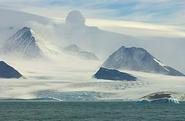
After the spectacular 2002 collapse of Antarctica's Larsen B Ice Shelf, an area roughly the size of Rhode Island, Eugene Domack, professor of geosciences at Hamilton College, led the first team of scientists into the area that had been undisturbed for nearly 10,000 years. Domack, who was investigating the cause for the shelf's collapse as well as the Antarctic Peninsula's response to warming, made a serendipitous discovery in 2005, a vast ecosystem beneath the collapsed ice shelf made up of a thriving clam community, mud volcanoes and bacterial mats.
Known as a cold-seep community, the ecosystem is the first finding of this type in the Antarctic. The discovery could provide evidence for researchers to better understand the dynamics within the inhospitable sub-ice setting, which covers nearly 580,000 square miles of seafloor.
Accompanied by five Hamilton students, Domack will return to the area to search for clues in the sediment of Antarctica's seafloor when he embarks on a month-long expedition to Antarctica on April 11. Researchers from seven collaborating U.S. and international institutions* will participate in this expedition that is among the very few that include undergraduate student researchers. For more on the expedition and to view daily journal entries and photos from the ship, visit www.hamilton.edu/antarctica.
In addition to sampling and mapping the ecosystem discovered last year, Domack says the team hopes to outline the longer-term history of the Larsen Ice B and possibly C shelves by collecting sediments that are believed to be more than 10,000 years old.
The Antarctic Peninsula, which juts northward off the western part of the continent, is experiencing greater warming than almost anywhere on Earth. The Peninsula warmed by an approximately of 4.5 degrees Fahrenheit in the past 60 years, and lost 5,200 square miles of ice in the past three years. "Our work contributes to the understanding of these climatic changes -- where they are occurring first and with greatest magnitude and impact upon the environment," says Domack.
Over the past 25 years, Domack has studied the paleohistory of Antarctica and investigated how glaciers move sediment off the land and into the ocean. He was awarded $851,941 from the National Science Foundation (NSF) Office of Polar Programs in 2004 for a three-year study aimed at understanding how Antarctica's climate has varied over the past hundreds and thousands of years, and how those changes have shaped the continent, particularly its ice shelves.
In the cover article of the August 4, 2005 issue of the journal Nature, Domack published the first evidence that the collapse of Antarctica's Larsen B Ice Shelf was unprecedented during the past 10,000 years. Using data collected from sediment core samples in the vicinity of the former ice shelf, Domack and his colleagues concluded that the Larsen ice shelf had been intact but was slowly thinning during the course of the current interglacial period.
*Collaborators on the project include researchers from Hamilton College; Colgate University; Montclair State University; Queens University in Kingston, Ontario; Southern Illinois University at Carbondale; Earth and Space Research, a non-profit institute; Istituto Nazionale di Oceanografia e di Geofisica Sperimentale - OGS, Trieste, Italy; and the Woods Hole Oceanographic Institution.
Known as a cold-seep community, the ecosystem is the first finding of this type in the Antarctic. The discovery could provide evidence for researchers to better understand the dynamics within the inhospitable sub-ice setting, which covers nearly 580,000 square miles of seafloor.
Accompanied by five Hamilton students, Domack will return to the area to search for clues in the sediment of Antarctica's seafloor when he embarks on a month-long expedition to Antarctica on April 11. Researchers from seven collaborating U.S. and international institutions* will participate in this expedition that is among the very few that include undergraduate student researchers. For more on the expedition and to view daily journal entries and photos from the ship, visit www.hamilton.edu/antarctica.
In addition to sampling and mapping the ecosystem discovered last year, Domack says the team hopes to outline the longer-term history of the Larsen Ice B and possibly C shelves by collecting sediments that are believed to be more than 10,000 years old.
The Antarctic Peninsula, which juts northward off the western part of the continent, is experiencing greater warming than almost anywhere on Earth. The Peninsula warmed by an approximately of 4.5 degrees Fahrenheit in the past 60 years, and lost 5,200 square miles of ice in the past three years. "Our work contributes to the understanding of these climatic changes -- where they are occurring first and with greatest magnitude and impact upon the environment," says Domack.
Over the past 25 years, Domack has studied the paleohistory of Antarctica and investigated how glaciers move sediment off the land and into the ocean. He was awarded $851,941 from the National Science Foundation (NSF) Office of Polar Programs in 2004 for a three-year study aimed at understanding how Antarctica's climate has varied over the past hundreds and thousands of years, and how those changes have shaped the continent, particularly its ice shelves.
In the cover article of the August 4, 2005 issue of the journal Nature, Domack published the first evidence that the collapse of Antarctica's Larsen B Ice Shelf was unprecedented during the past 10,000 years. Using data collected from sediment core samples in the vicinity of the former ice shelf, Domack and his colleagues concluded that the Larsen ice shelf had been intact but was slowly thinning during the course of the current interglacial period.
*Collaborators on the project include researchers from Hamilton College; Colgate University; Montclair State University; Queens University in Kingston, Ontario; Southern Illinois University at Carbondale; Earth and Space Research, a non-profit institute; Istituto Nazionale di Oceanografia e di Geofisica Sperimentale - OGS, Trieste, Italy; and the Woods Hole Oceanographic Institution.
Posted April 13, 2006
